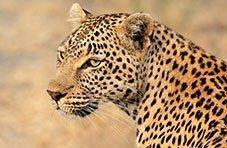African leopard is yet another of the Big Five, teamed up with the African lion, African elephant, Cape buffalo and rhinoceros. Each of these animals were considered difficult and dangerous to hunt on foot, which is why the hunters have long ago coined the term Big Five, marking them as sought-after trophies. Today you can see these magnificent creatures in flesh while taking part in a wildlife safari, and joining us here you might learn some interesting things you never knew about them.
The Big Kitty
Leopard is one of the four "big cats”, the other three being tiger, jaguar and lion. Beautiful and dramatic, this solitary animal is powerfully built with a long body and relatively short legs. Leopard’s coat is covered in spots which are circular in East African leopards but square in Southern African leopards. The spots, along with the colour of their coats, provide a perfect camouflage and allow them to blend in with their surroundings.
This big cat has long whiskers which it uses as antennae to judge space between bushes and trees. As leopards are mostly active at night, this an essential tool for hunting. During the day, they generally remain hidden and rest.
Just like a domestic cat, leopard will growl and spit when angry and purr when content. To announce his presence to others of his kind, he’ll produce a rasping cough.
My Home Is My Own
Leopards are solitary animals and each has its own space which he’ll fiercely defend. An area “belonging” to one male leopard will not overlap with another male’s, but might with the ranges of several females he can mate with. To mark its range and warn intruders to stay away, the big cat will use urine and leave claw marks on trees.
When choosing their habitat, rocky landscapes with dense bush and riverine forests are leopard’s preferred option. In Africa, they have inhabited mountain forests as well as grasslands and savannahs. Generally, they are very adaptable to different locations and both cold and warm climate, which is why they’ve been able to survive in various geographic areas.
The Skilled Hunter
This large carnivore is a master stalker and uses surprise to capture his pray. When stalking it, he’ll keep low while moving through the grass, until he’s close enough to attack. He has extremely acute vision and hearing, and can move slowly and silently. Leopard is able to run as fast as 60km/h and leap 3m vertically and 6m horizontally. He can also swim and occasionally eats fish and crabs, but is also quite capable of killing pray which is larger than himself.
Leopard’s diet is quite versatile and he’ll go after reptiles, rodents, birds, as well as hares, antelopes, deer and pigs. They’ve even been observed killing young giraffes, weighing up to three times the leopard’s body weight. He’ll often drag his kill up into the trees to protect it from thieving lions and hyenas and feed there. So be careful when passing under big old trees with thick branches, there might be a leopard up there snacking or taking a nap.
When he’s not hunting, leopard will stroll through antelope herds without giving them a second look. To indicate they’re not in danger, he’ll flip his tail over his back and reveal the white underside. Don’t panic guys, just taking a walk!
A Caring Mum
Leopards make great mums and take good care of their young. Gestation period typically lasts 2.5 months and results in a litter of two to three cubs weighing on average half a kilogram. After they are born, leopard mum will keep the cubs hidden and move them from one location to another by carrying them in her jaw. The young ones will stay with their mothers for up to two years, which is when they reach their sexual maturity. When little, cubs learn to hunt by stalking and pouncing a variety of objects, such as leaves, sticks and siblings.
A National Geographic program has shown a wild leopard which has killed a baboon in order to feed. However, after noticing an infant baboon next to its dead mum, the leopard carried the baby up to the tree to guard it from hyenas. She has stayed with it during the night, grooming and cuddling it, as if it was her own cub.
The Human Threat
Two major threats are listed when it comes to African leopard, one being the habitat conversion and the other an intense persecution by men. Including them in the Big Five group makes it clear hunters see leopards as valuable trophies. However, they struggle to locate the big cats as they are only out and about from sunset to sunrise and well camouflaged to blend in with their surroundings.
In 1986 African leopards were listed as ‘vulnerable’ by IUCN, citing that “leopard populations have become reduced and isolated and they are now extirpated from large portions of their historic range”. Future decline is anticipated unless conservation efforts are taken. When you look at this beautiful animal, doesn’t that make you sad?




